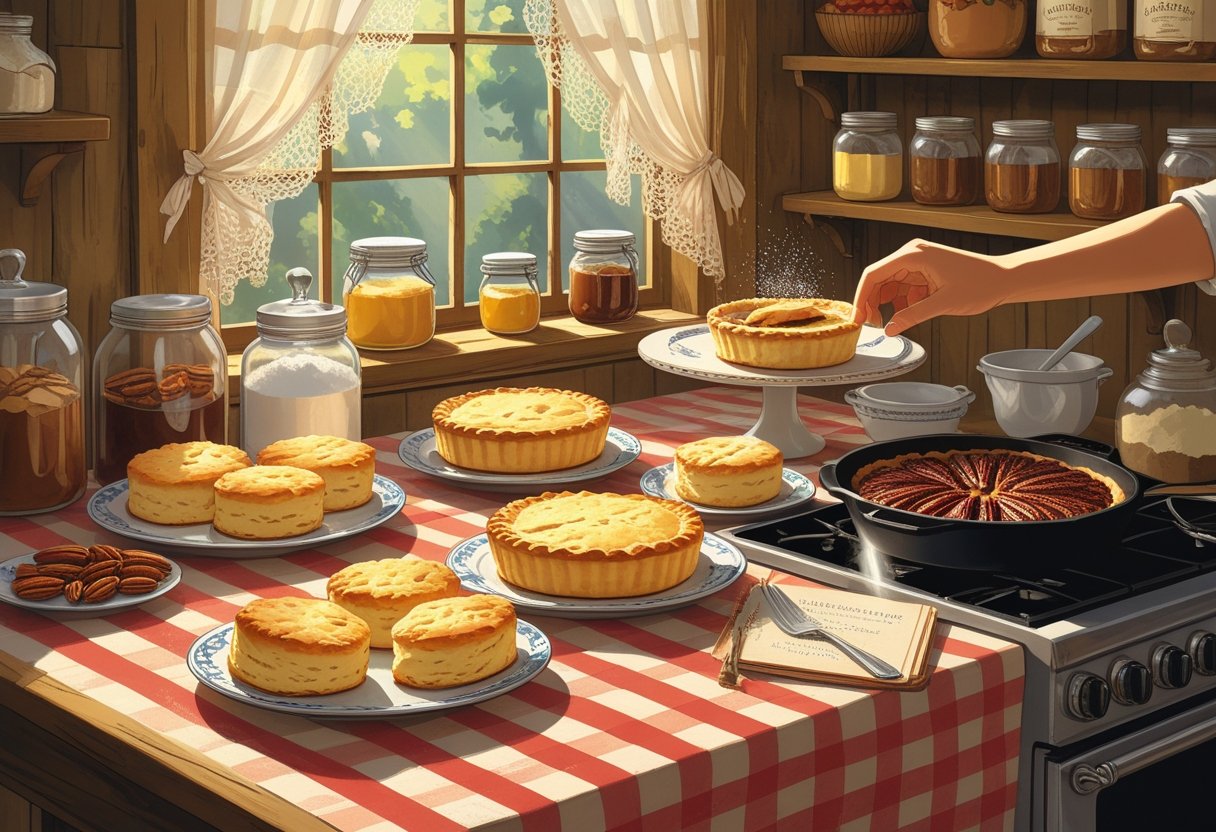Southern baking isn’t just about following a set of steps; it’s this mix of tradition, a dash of precision, and a whole lot of handed-down know-how. Getting your ingredients right and nailing a few key techniques really does make a difference. Here are some practical tips straight from the heart of Dixie, so you can bake Southern favorites with a bit more confidence—and maybe even a little swagger.

It’s all in the details—from picking the right sugar to understanding how temperature changes everything. These tips blend old-school wisdom with a few modern shortcuts, keeping things authentic while making baking a lot less intimidating.
Key Takeaways
- Specific ingredients matter for real-deal Southern baking.
- Timing and temperature control are your secret weapons.
- Mixing tradition with a few new tricks makes recipes shine.
Essential Southern Baking Ingredients
Southern baking leans hard on certain ingredients that shape texture, flavor, and that unmistakable authenticity. Every piece—from the flour you use to the ripeness of your fruit—can make or break a recipe.
Choosing the Right Flour and Cornmeal
Most Southern recipes call for all-purpose flour. It’s got just enough protein for a soft crumb, not so much that things get tough. For biscuits or pie crusts, unbleached flour gets the nod. It brings out flavor and helps keep the structure in check.
Cornmeal’s a must for cornbread. Stone-ground is the favorite—it’s coarser and gives a deeper flavor than the fine stuff. Keep it in a cool, dry spot to avoid it going off. Trust me, rancid cornmeal will ruin your day.
How you combine flour and cornmeal changes the final product. Play with the ratio if you want your bake lighter or more rustic—there’s no one-size-fits-all.
The Role of Buttermilk and Sweet Cream Butter
Buttermilk is a Southern staple. Its acidity reacts with baking soda or powder, giving biscuits and cakes a nice lift and that little tang. Go for cultured buttermilk—it’s more consistent and easier to work with.
As for butter, unsalted sweet cream is where it’s at. It melts evenly, tastes clean, and makes pastries flaky. Margarine or shortening just can’t compete here.
Freshness matters. Old buttermilk or butter can throw off the flavor and texture, so check dates or give it a sniff before you start.
Selecting Fresh Local Produce for Baked Goods
Fresh, local ingredients really do make a difference. Peaches, pecans, sweet potatoes—if you can get them in season and close to home, the flavor pops. Plus, you get a little more nutrition out of it.
Pick peaches that are ripe but still firm, so your pies and cobblers don’t turn to mush. Toast your pecans before baking—they’ll taste way better.
Seasonal produce means you’re working with fruits and veggies at their best. You won’t need as much sugar or fake flavoring that way.
Proven Techniques for Authentic Southern Flavor
Getting Southern baking right is about more than the ingredients. It’s timing, temperature, and those little moves—like cutting cold fat into flour or balancing sweet and tart—that make the difference.
Mastering the Art of Biscuit Making
Cold ingredients are a must for biscuits. Chilled butter or shortening melts as it bakes, creating steam and those coveted flaky layers.
Don’t overwork the flour. Mix just until things come together, and fold the dough a couple of times. That’s how you get biscuits that are fluffy, not hockey pucks.
Bake in a hot oven—425°F to 450°F is about right. If you’ve got a baking stone or can preheat your baking sheet, even better for browning and rise.
Secrets to Light and Fluffy Cakes
Creaming butter and sugar until they’re pale and fluffy makes a big difference in Southern cakes. It adds air, giving you a tender crumb.
Sift your dry ingredients so the batter stays light. Buttermilk or sour cream adds acidity, which teams up with baking soda for extra lift and keeps things balanced.
Don’t overmix after adding flour. That’s how you get dense, heavy cake. And keep an eye on the oven—checking a little early is better than risking dryness.
Perfecting Southern Pies and Cobblers
Pie crusts turn out best when you cut cold fat into flour until you see pea-sized bits. That’s your ticket to flaky, tender crust—not the tough stuff.
For fillings, balance sweet fruit with a splash of lemon juice or vinegar. Tapioca or cornstarch helps thicken things up without making your pie soupy.
Cobblers are simple—drop biscuit dough on hot fruit and bake until golden. Don’t fuss with the dough too much, and brush with butter at the end for a little extra richness.
Timing, Temperature, and Tools for Success
Controlling oven temp and picking the right bakeware can make or break your baking. It’s also about knowing when things are actually done—timers help, but your senses matter more.
Precise Oven Temperatures and Bakeware Choices
Southern baking usually wants oven temps between 325°F and 375°F. Ovens can be liars, so use a thermometer if you can. You’d be surprised how many ovens run hot or cold.
Bakeware matters. Glass pans heat up slower but hold onto heat, which can brown edges too fast in cakes. Aluminum pans heat quickly and evenly—great for cakes, biscuits, and cornbread. Non-stick pans? Drop the temp a bit or shave a few minutes off, or you might overdo it.
Keep racks in the center for even baking. If you’re using a dark or heavy pan, lower the temp by 25°F to dodge burning your edges.
How to Test for Doneness
For cakes, poke the center with a toothpick or skewer. If it comes out clean or with a couple crumbs, you’re good. Wet batter means it needs more time.
Biscuits and cornbread should be golden at the edges and sound hollow when you tap the bottom. Trust your eyes and fingers more than the clock—every oven’s got its quirks.
Timers help, but those little physical tests are what keep you from ending up with dry or underdone bakes.
Preserving Tradition While Adding a Modern Twist
Keeping the heart of Southern baking doesn’t mean you can’t tweak things. It’s about respecting the old ways, but not being afraid to make changes that fit your kitchen or your taste.
Adapting Classic Recipes for Today’s Kitchen
Modernizing Southern recipes usually comes down to swapping ingredients or tools, but the goal’s always the same—don’t lose the flavor or texture that makes it Southern. Stand mixers can save you time, but mix gently to avoid overdoing it.
Ovens are unpredictable, so check for doneness before the timer’s up. If you’re out of buttermilk, mixing milk with a splash of vinegar works in a pinch.
Cutting back a little on sugar or salt can fit today’s tastes, and storing pastries in airtight containers or the fridge can help them last longer—especially things like sweet potato pie.
Incorporating New Flavors Without Compromising Authenticity
Adding flavors like bourbon, pecan, or a touch of citrus zest can really liven up traditional Southern baked goods without losing what makes them special. The trick? Don’t go overboard—a little smoked paprika or lavender can be interesting, but you don’t want it taking over the whole show.
Trying out seasonal fruits or swapping in natural sweeteners like honey shakes things up just enough. Peach with cinnamon, blackberry with vanilla—those combos still feel right at home in Southern baking.
If you’re messing with spices or extracts, it’s smart to go slow and taste as you go. You still want that classic moistness and crumb, so don’t let the new flavors throw off the balance.

